Eliza Knight's Blog, page 41
March 7, 2013
New Release! Notorious Woman!
Happy release day to my alter ego, Annabelle Weston! Today the 3rd book in the Desert Heat series released!
 Notorious Woman...
Kate has a bad reputation. Since her pa’s murder, she’s been a whip-wielding, ball-busting hellcat, determined to prove she can run a ranch just as well as any man. Then her little sister goes and hires a new foreman—a foreman who makes Kate tingle in places she shouldn’t be tingling, not if she wants to keep up a tough façade. When Jake takes liberties by kissing her—never mind where he kisses her—she clocks him in the chin then hopes he’ll kiss her some more. What’s happening to her?Jake isn’t just at the ranch to help run the place. He made a bet he could tame Kate, a bet that would give him the money he needs for his own piece of land. He never expected her to be so ornery…or taste so sweet. And he never expected to like her more when she’s cantankerous. Unfortunately, it’s a bet he can’t afford to lose, even though he’s already lost his heart.Inside Scoop: This historical romp is a sexy Western take on The Taming of the Shrew.An Excerpt From: NOTORIOUS WOMANCopyright © ANNABELLE WESTON, 2013All Rights Reserved, Ellora's Cave Publishing, Inc.About a quarter mile from the gate, he came upon a farmhouse, what appeared to be a bunkhouse on the left and a shed for a farrier on the right. Both could use a coat of fresh stucco. As Jake rode up to the house, he came to the conclusion these ladies were over their pretty little heads.A chicken coop listed to one side. A few chickens scratched the dry earth. He doubted they laid a decent egg to breakfast on. The first winter storm would most likely knock the coop over. No self-respecting coyote would have any trouble breaking in and helping himself to a not-so-plump chicken dinner.There was a good-sized barn with an empty corral behind it. Beyond the corral, a pasture where livestock should be grazing. He frowned. The girls had no idea how to run a ranch and obviously that idiot of a foreman who had worked for their pa didn’t either. Nobody had done a lick of work in a long time. Damn good thing he’d come along when he did. He’d fix the place right up.Whoa there, boy! What was he doing? Thinking like that would have him trying to make a permanent home out of Crowley ranch. That wasn’t how it was going to be. He was going to win this wager and then get on to Texas where the real cattlemen lived. In his pocket would be a fat purse—enough to buy his own place.Best to keep his goal in mind, else he’d wind up draining his blood and sweat on this spread with nothing to show for his effort.Kate Crowley came out on her porch carrying a lit coal-oil lamp as the sun was about to set. She wore riding clothes and a hat. Thankfully, he didn’t see any whip or other weapon.A gust of wind whipped her loose hair and reddened her cheeks. He had to admit she made a picture of Western country womanhood any man would be itching to come home to. The fact that for a split-second he thought of coming home to her disturbed him greatly.Her eyes met his and he couldn’t help but notice taut nipples beneath her blouse. Jake sucked in a breath, his own body reacting with sudden lust. She drew a wool shawl tighter around her shoulders. It hugged her curves and gave the impression of vulnerability. She appeared sturdy enough, he reckoned, but there was no mistaking she was holding her own against a stacked deck.“You found us,” she said kindly. In the dying light, Jake could see the gratitude reflected in her eyes.“Yes ma’am.” Jake tipped his hat. He couldn’t afford to be sorry for her plight. Like he’d told the boys at the saloon, her dilemma wasn’t his concern. In six weeks, he’d be a man of means. Most likely, the sisters would be on their way back East, where ladies belonged. “You here to check on my sobriety?”“Do I need to?”He chuckled. She gave as good as she got.“Come with me,” she said and stepped down from her perch. “I’ll show you where to put your gear.”Like a general who’d just given orders, she marched off, her head high. He couldn’t help but watch the sway of her hips. No matter how much she tried to be one of the boys, this woman had virtues no man could ignore.Resolve twitched his lips as he pictured her walking like that without any clothes on. Her ass would sway and dimple with each step. He imagined the curve of her bottom as he held her. Damn if he didn’t wonder what she’d be like underneath him. Would her fire scorch him?His cock grew hard, pressing uncomfortably against his denim. He adjusted his stance, giving himself a chance to settle down.Jake led Rascal to the bunkhouse where Kate stood waiting by the open door. She went inside, hung the lantern on a wooden peg and set the bedding on the nearest bunk. Her hands lingered a moment on the rough mattress, and seeing her bent over like that, Jake had the urge to come up behind her and press his aching cock against the curve of her buttocks.Clearing his throat, hoping to gain some control of his lust, he asked, “Where are the other wranglers?” Jake poked his head inside.“There aren’t any others,” she said, furrowing her forehead.He raised a brow. She had to be joking. “You hired me to be a foreman. You mean to tell me I’m the only hombre working here?”Her lips pressed together as she watched him, almost as if she was annoyed that he would question her. But question her he would. This was not the job he’d agreed to. Foreman was one thing. Doing the job of a dozen wranglers wasn’t.“You’re our only employee. We can’t afford to hire any more help right now.”“How in the heck do you expect to get the considerable amount of work that needs doing finished by the time winter rolls in?” He stared hard at her. “Which will be sooner than you think.”Kate stepped forward, her shoulders pulled back, breasts pushed tight against her blouse. The intent he knew was to appear taller, stronger, but instead she looked hotter than hell and had him thinking of hauling her into his arms to feel the softness pressed against him. “I intend to do my share of the work. My sister too.”Jake let out a whistle. “You must be joshing. I can’t bring cows down from these hills with a couple of women.”Her eyes glowed in the lamplight. “That’s exactly what we are going to do, Mr. Madden. Are you telling me you’re not able to do the job?”Jake pushed his hat back on his head. Was she questioning his abilities? He didn’t like what he saw but he wasn’t going to back down with so much at stake.“I didn’t think so.” She rested her hands on her hips. Ample, curving hips. “You can put your horse in the barn.”“No thanks. He’ll do fine in the corral. No use spoiling him.”“Suit yourself.”When she brushed past him, heat encompassed him. Instinctively Jake reached out, stopping her. She glanced up at him, fire filling her eyes. He breathed deep. She smelled of flowers, sugar. Gripping a tendril of her loose hair, he twirled it around his fingers.“What are you doing?” Her voice was soft, husky, giving away that she was more affected by his simple touch than her words showed.What was he doing? He wanted to kiss her. To touch her.Instead Jake shook his head, pulling himself from whatever spell had overtaken him. He blinked a few times, dropping his hand to his side.READ IT!Check out the other books in the Desert Heat series!!
Notorious Woman...
Kate has a bad reputation. Since her pa’s murder, she’s been a whip-wielding, ball-busting hellcat, determined to prove she can run a ranch just as well as any man. Then her little sister goes and hires a new foreman—a foreman who makes Kate tingle in places she shouldn’t be tingling, not if she wants to keep up a tough façade. When Jake takes liberties by kissing her—never mind where he kisses her—she clocks him in the chin then hopes he’ll kiss her some more. What’s happening to her?Jake isn’t just at the ranch to help run the place. He made a bet he could tame Kate, a bet that would give him the money he needs for his own piece of land. He never expected her to be so ornery…or taste so sweet. And he never expected to like her more when she’s cantankerous. Unfortunately, it’s a bet he can’t afford to lose, even though he’s already lost his heart.Inside Scoop: This historical romp is a sexy Western take on The Taming of the Shrew.An Excerpt From: NOTORIOUS WOMANCopyright © ANNABELLE WESTON, 2013All Rights Reserved, Ellora's Cave Publishing, Inc.About a quarter mile from the gate, he came upon a farmhouse, what appeared to be a bunkhouse on the left and a shed for a farrier on the right. Both could use a coat of fresh stucco. As Jake rode up to the house, he came to the conclusion these ladies were over their pretty little heads.A chicken coop listed to one side. A few chickens scratched the dry earth. He doubted they laid a decent egg to breakfast on. The first winter storm would most likely knock the coop over. No self-respecting coyote would have any trouble breaking in and helping himself to a not-so-plump chicken dinner.There was a good-sized barn with an empty corral behind it. Beyond the corral, a pasture where livestock should be grazing. He frowned. The girls had no idea how to run a ranch and obviously that idiot of a foreman who had worked for their pa didn’t either. Nobody had done a lick of work in a long time. Damn good thing he’d come along when he did. He’d fix the place right up.Whoa there, boy! What was he doing? Thinking like that would have him trying to make a permanent home out of Crowley ranch. That wasn’t how it was going to be. He was going to win this wager and then get on to Texas where the real cattlemen lived. In his pocket would be a fat purse—enough to buy his own place.Best to keep his goal in mind, else he’d wind up draining his blood and sweat on this spread with nothing to show for his effort.Kate Crowley came out on her porch carrying a lit coal-oil lamp as the sun was about to set. She wore riding clothes and a hat. Thankfully, he didn’t see any whip or other weapon.A gust of wind whipped her loose hair and reddened her cheeks. He had to admit she made a picture of Western country womanhood any man would be itching to come home to. The fact that for a split-second he thought of coming home to her disturbed him greatly.Her eyes met his and he couldn’t help but notice taut nipples beneath her blouse. Jake sucked in a breath, his own body reacting with sudden lust. She drew a wool shawl tighter around her shoulders. It hugged her curves and gave the impression of vulnerability. She appeared sturdy enough, he reckoned, but there was no mistaking she was holding her own against a stacked deck.“You found us,” she said kindly. In the dying light, Jake could see the gratitude reflected in her eyes.“Yes ma’am.” Jake tipped his hat. He couldn’t afford to be sorry for her plight. Like he’d told the boys at the saloon, her dilemma wasn’t his concern. In six weeks, he’d be a man of means. Most likely, the sisters would be on their way back East, where ladies belonged. “You here to check on my sobriety?”“Do I need to?”He chuckled. She gave as good as she got.“Come with me,” she said and stepped down from her perch. “I’ll show you where to put your gear.”Like a general who’d just given orders, she marched off, her head high. He couldn’t help but watch the sway of her hips. No matter how much she tried to be one of the boys, this woman had virtues no man could ignore.Resolve twitched his lips as he pictured her walking like that without any clothes on. Her ass would sway and dimple with each step. He imagined the curve of her bottom as he held her. Damn if he didn’t wonder what she’d be like underneath him. Would her fire scorch him?His cock grew hard, pressing uncomfortably against his denim. He adjusted his stance, giving himself a chance to settle down.Jake led Rascal to the bunkhouse where Kate stood waiting by the open door. She went inside, hung the lantern on a wooden peg and set the bedding on the nearest bunk. Her hands lingered a moment on the rough mattress, and seeing her bent over like that, Jake had the urge to come up behind her and press his aching cock against the curve of her buttocks.Clearing his throat, hoping to gain some control of his lust, he asked, “Where are the other wranglers?” Jake poked his head inside.“There aren’t any others,” she said, furrowing her forehead.He raised a brow. She had to be joking. “You hired me to be a foreman. You mean to tell me I’m the only hombre working here?”Her lips pressed together as she watched him, almost as if she was annoyed that he would question her. But question her he would. This was not the job he’d agreed to. Foreman was one thing. Doing the job of a dozen wranglers wasn’t.“You’re our only employee. We can’t afford to hire any more help right now.”“How in the heck do you expect to get the considerable amount of work that needs doing finished by the time winter rolls in?” He stared hard at her. “Which will be sooner than you think.”Kate stepped forward, her shoulders pulled back, breasts pushed tight against her blouse. The intent he knew was to appear taller, stronger, but instead she looked hotter than hell and had him thinking of hauling her into his arms to feel the softness pressed against him. “I intend to do my share of the work. My sister too.”Jake let out a whistle. “You must be joshing. I can’t bring cows down from these hills with a couple of women.”Her eyes glowed in the lamplight. “That’s exactly what we are going to do, Mr. Madden. Are you telling me you’re not able to do the job?”Jake pushed his hat back on his head. Was she questioning his abilities? He didn’t like what he saw but he wasn’t going to back down with so much at stake.“I didn’t think so.” She rested her hands on her hips. Ample, curving hips. “You can put your horse in the barn.”“No thanks. He’ll do fine in the corral. No use spoiling him.”“Suit yourself.”When she brushed past him, heat encompassed him. Instinctively Jake reached out, stopping her. She glanced up at him, fire filling her eyes. He breathed deep. She smelled of flowers, sugar. Gripping a tendril of her loose hair, he twirled it around his fingers.“What are you doing?” Her voice was soft, husky, giving away that she was more affected by his simple touch than her words showed.What was he doing? He wanted to kiss her. To touch her.Instead Jake shook his head, pulling himself from whatever spell had overtaken him. He blinked a few times, dropping his hand to his side.READ IT!Check out the other books in the Desert Heat series!!
Published on March 07, 2013 05:33
March 6, 2013
Castle of the Week: Bishop's Castle
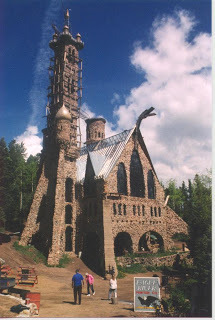 Welcome back to another castle of the week! This week's castle is Bishop's Castle in Colorado (USA) and is presented to you by Joan Maze! Enjoy!
Welcome back to another castle of the week! This week's castle is Bishop's Castle in Colorado (USA) and is presented to you by Joan Maze! Enjoy!BISHOP’S CASTLE – COLORADOby Joan MazeYes, Coloradohas a castle, a replica of a medieval structure that is still in progress, one called “The craziest castle in Colorado” by Rob Owen of the Pittsburgh Post-Gazette.
As he indicated, one could easily miss the castle except for the cars parked at the side of the scenic highway in the San Gabriel National Forest. Some years ago, when visiting my sister in Colorado, we took one of our many tours of the area, and this one brought us by Bishop’s Castle.
We didn’t visit the castle as, I believe, they weren’t taking visitors at the time, but we stopped and I peered into the forest, trying to see the castle. I did see the very top peeking through the dense woods, and it fueled my imagination and tickled my senses.
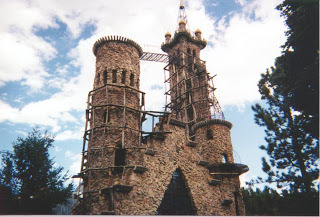 The castle is open daily, year-round, but during daylight hours only. Admission is free, but donations are requested. The castle is located less than an hour’s drive from Pueblo. Information is available at www.bishopcastle.orgunder “Visiting the Castle.” Further details can be obtained by calling 1-719-485-3040.According to the reporter:
The castle is open daily, year-round, but during daylight hours only. Admission is free, but donations are requested. The castle is located less than an hour’s drive from Pueblo. Information is available at www.bishopcastle.orgunder “Visiting the Castle.” Further details can be obtained by calling 1-719-485-3040.According to the reporter:Made of native stone that castle builder Jim Bishop extracted (by permit) from adjacent national forest land, the castle features intricate wrought-iron bridges and walkways that cling to its towers. Bishop Castle is decorated with stained-glass windows along its front wall; a metallic dragon's neck and head jut from the apex of the castle's great hall. The dragon, made from recycled metal hospital trays, shoots fire from its gaping maw with the aid of a burner from a hot air balloon. The castle's fireplace vents through the dragon's nose, expelling smoke from the beast's nostrils.
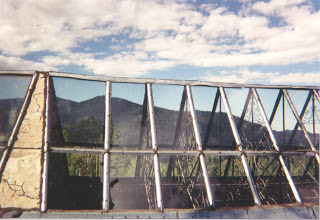 This unique castle in “cowboy country” was, and still is, being constructed by one man. At the age of 15, Mr. Bishop purchased the 2 ½ acres for $1,250. Started as a family cabin in June of 1969, the structure grew to the castle visitors see today. As the reporter said, Fearless children clamber up its concrete steps and along the wrought-iron balconies. Their more inhibited parents move cautiously behind them, marveling at the craftsmanship of the hand-laid stone and metal work, including a basket-style lift that runs on a track from the ground up to the castle's great hall level.
This unique castle in “cowboy country” was, and still is, being constructed by one man. At the age of 15, Mr. Bishop purchased the 2 ½ acres for $1,250. Started as a family cabin in June of 1969, the structure grew to the castle visitors see today. As the reporter said, Fearless children clamber up its concrete steps and along the wrought-iron balconies. Their more inhibited parents move cautiously behind them, marveling at the craftsmanship of the hand-laid stone and metal work, including a basket-style lift that runs on a track from the ground up to the castle's great hall level.
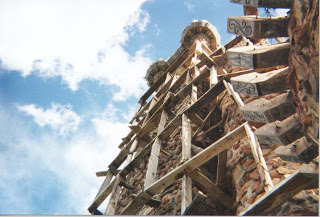 Originally planned as a getaway to be in the mountains, hunting, fishing, climbing, etc., it was originally a family project, but Jim Bishop’s father quit the project in 1971 and Jim continued on. He and his family live in Pueblo. Because he used stone to build the initial cabin ("We were too poor to buy conventional building materials," he said), passers-by said it resembled a castle. So he decided that's what it would be and kept going. In 1971, Mr. Bishop's father, Willard, quit the project, and Jim Bishop has done pretty much all the work since, a point of some contention. "It is Jim, and only Jim, who has built the castle," reads the Frequently Asked Questions page at the castle's Web site, www.bishopcastle.org. On a water tank in the oldest corner of the castle, Mr. Bishop has scrawled a note explaining that his father helped with that part only. "Jim Bishop has constr. [sic] (by hand) everything else!"
Originally planned as a getaway to be in the mountains, hunting, fishing, climbing, etc., it was originally a family project, but Jim Bishop’s father quit the project in 1971 and Jim continued on. He and his family live in Pueblo. Because he used stone to build the initial cabin ("We were too poor to buy conventional building materials," he said), passers-by said it resembled a castle. So he decided that's what it would be and kept going. In 1971, Mr. Bishop's father, Willard, quit the project, and Jim Bishop has done pretty much all the work since, a point of some contention. "It is Jim, and only Jim, who has built the castle," reads the Frequently Asked Questions page at the castle's Web site, www.bishopcastle.org. On a water tank in the oldest corner of the castle, Mr. Bishop has scrawled a note explaining that his father helped with that part only. "Jim Bishop has constr. [sic] (by hand) everything else!" At one time Mr. Bishop allowed others to lend a hand here and there, but he had bad experiences with unskilled laborers getting in his way.Following are photographs of this amazing castle, which I hope one day to be able to visit. My imagination has now conjured up a suspense/mystery of a woman fleeing for her life who comes upon the castle. But is there additional danger there?Joan K. MazeWriting as J. K. Mazewww.joanmaze.com
At one time Mr. Bishop allowed others to lend a hand here and there, but he had bad experiences with unskilled laborers getting in his way.Following are photographs of this amazing castle, which I hope one day to be able to visit. My imagination has now conjured up a suspense/mystery of a woman fleeing for her life who comes upon the castle. But is there additional danger there?Joan K. MazeWriting as J. K. Mazewww.joanmaze.com
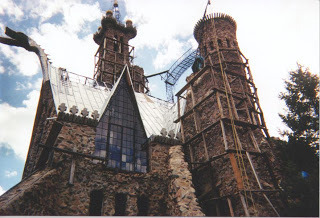
Published on March 06, 2013 05:40
February 27, 2013
Castle of the Week: Chenonceau: The ladies’ chateau
Welcome back to another castle of the week! This week's castle is Chenonceau (also written as Chenonceaux), in France! Enjoy!
Chenonceau: The ladies’ chateauby McKenna Darby
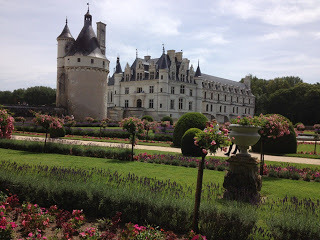 Chateau de Chenonceau as seen from Catherine de Medici's garden. It is
Chateau de Chenonceau as seen from Catherine de Medici's garden. It is
widely considered the most beautiful chateau in France and one of the most
beautiful in the worldChenonceau is one of France’s smaller castles. What it lacks in size, however, Chenonceau more than makes up for in history – and in beauty. As Laure Menier, curator of Chenonceau writes in her introduction to one the chateau’s many guidebooks: “The very name of this site evokes music; the vision of it, pure enchantment. Here charm transcends beauty. The majesty and simplicity of Chenonceau touches the heart and the soul.” Poetic, yes, but Chenonceau is every bit of this and more.
The chateau is distinctive in part for being constructed in the middle of the Cher River. The river, placid as a lake on fair days, reflects the castle’s white stone and dainty turrets like a noble lady’s looking glass. Which is appropriate, for Chenonceau is popularly known as “the ladies’ chateau.” Through the centuries, six strong and memorable women built Chenonceau, maintained it, expanded it, loved it, fought over it, and made its place in history.
The first was Katherine Briçonnet. Katherine’s husband, Thomas Bohier, acquired the property from the debt-ridden Marques family in 1496, and proceeded to tear down both the medieval castle and mill that stood there. Only the Marques tower, which Katherine renovated in Renaissance style, still stands near the castle’s front entrance. On the foundations of the previous castle and mill, Katherine and Thomas built a new castle, almost perfectly square. With Thomas was away for long periods, tending to the king’s finances, Katherine supervised most of the construction. The castle’s ornate double doors and an Italian-style coffered-oak ceiling, the oldest surviving example in France, are widely attributed to Katherine’s influence.Shortly after Thomas died, King Francis I seized the chateau as part of a lawsuit against his financiers; Chenonceau became a royal castle. Men were not destined to control the castle, however. Francis died soon after he gained control of the property, and control passed to his son, Henri II.
Henri had two important women in his life: his wife, Catherine de Medici, and his mistress, Diane de Poitiers. Although Catherine assumed she would control the castle, Henri awarded it to Diane instead. The decisions enraged the queen, but Catherine was 20 years younger than her rival. In keeping with her famous motto, “Hate and wait,” Catherine bided her time, expecting that Diane would soon die. Instead, the notoriously athletic and healthy Diane applied her talent for business management to develop a thriving farm at the chateau. She then used the farm’s proceeds and the estate’s rents to renovate and enlarge Chenonceau, constructing some of the most spectacular gardens of the era and adding a scenic bridge that connected the chateau to the far bank of the Cher.
When King Henri died in a tragic jousting accident, Catherine no longer had to wait. She seized Chenonceau, evicted Diane, and set about to put her own mark on the castle. On the opposite side of the chateau from Diane’s garden, Catherine built her own, complete with lemon and orange trees. She also built two galleries on top of Diane’s bridge, a project Diane had planned but never had a chance to execute. The dowager queen also built on Diane’s other accomplishments, transforming her rival’s vineyard into one of France’s finest, importing silkworms, and launching silk production that produced a fabric so fine it was known as “the Queen’s cloth.” She then set about to stage the most elaborate parties in the history of France, including lavish entertainments, sumptuous food, and nation’s first fireworks display, given in honor of her son, the newly crowned King Francis II, and his wife Mary Stuart. For nearly 30 years, for three sons in turn (Catherine survived all but the last), she ruled France as regent from the Thomas Bonier’s Green Study at Chenonceau.
When Catherine’s third son, Henri III, was assassinated on Aug. 1, 1589, Chenonceau passed to his widow, Louise de Lorraine. She transformed Chenonceau into a tomb, painting her bedchamber black and roaming the halls in white, the color of royal mourning. With her death in 1501, Chenonceau lost its last royal resident.The next important woman in Chenonceau’s history was Louise Dupin, who hosted the Enlightenment’s most famous thinkers, from Voltaire to Rousseau, at the chateau. When the French Revolution broke out and rioters threatened to destroy Chenonceau as a symbol of royal excess, Mme. Dupin saved the chateau by reminding the revolutionary mob of the castle’s hospitality to their Enlightenment heroes.
Early in the 20th century, Chenonceau was again touched by war. The chateau, now owned by the Menier family, a dynasty built on chocolate, became a hospital for soldiers wounded in World War I, with a 120-bed ward and a surgical facility set up in Catherine de Medici’s two galleries. The family paid all of the expenses, treating 2,254 soldiers before the war ended. Simone Menier, chief nurse, ran the hospital with her husband, George.
In World War II, Chenonceau played an important role in the French Resistance. On June 22, 1940, France lost a decisive battle that cut the country in two. The line of demarcation between Nazi-controlled France and free France ran along the Cher River. The far side of the bridge was Nazi controlled. The chateau side was free. Although German guards patrolled the river, Simone Meunier unlocked the doors to the gallery whenever the patrols were out of sight, helping hundreds of Jews and French villagers to escape.
 Catherine de Medici's garden reflects her flamboyant style. To the left isDiane's bridge, topped by Catherine's two-story gallery.
Catherine de Medici's garden reflects her flamboyant style. To the left isDiane's bridge, topped by Catherine's two-story gallery.
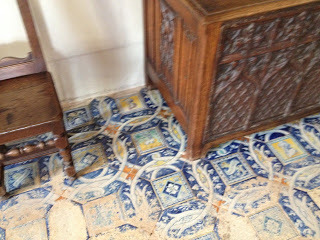 Some of the original Delft tiles at Chenonceau. Except around the edges ofthe room, the tiles are worn down to the red clay underneath.
Some of the original Delft tiles at Chenonceau. Except around the edges ofthe room, the tiles are worn down to the red clay underneath.
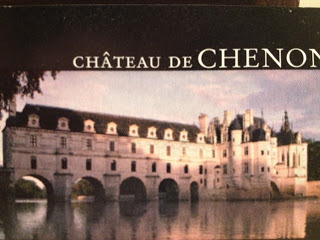 Chenonceau, as shown on my admission ticket. Diane de Poitiers built the
Chenonceau, as shown on my admission ticket. Diane de Poitiers built the
bridge over the River Cher. Diane's lifelong rival, Catherine de Medici, topped it with a double gallery when she seized the castle from her husband's mistress after the death of Catherine's husband, King Henri II. During WWII, the castle side of the bridge was free France, while the opposite sidewas Nazi occupied. Hundreds escaped Nazi control by slipping across the bridge with assistance from Simone Menier, heir to the Menier chocolatefortune, who worked with the French Resistance. A stunning view of the Cher and a corner of Diane's garden from Catherinede Medici's study
A stunning view of the Cher and a corner of Diane's garden from Catherinede Medici's study
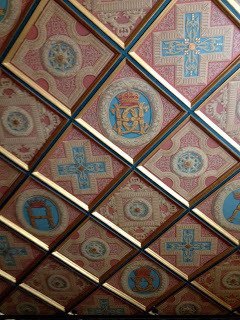 Ceiling in Catherine de Medici's study, from which she ruled France asregent to her sons for almost THIRTY years. Still in its original state, itfeatures the crest of Thomas Bohier and his wife, Katherine Briconnet, whodemolished the fortified castle and mill that once stood on the site tobuild CHENONCEAU.
Ceiling in Catherine de Medici's study, from which she ruled France asregent to her sons for almost THIRTY years. Still in its original state, itfeatures the crest of Thomas Bohier and his wife, Katherine Briconnet, whodemolished the fortified castle and mill that once stood on the site tobuild CHENONCEAU.
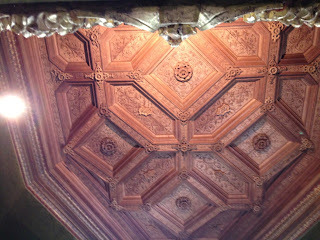 Intertwined H and Cs on the ceiling in Catherine de Medici's bedroom officially stand for Henri andCatherine, but are arranged so they also form an intertwined H and two Ds, forHenri and his mistress Diane de Poitiers.
Intertwined H and Cs on the ceiling in Catherine de Medici's bedroom officially stand for Henri andCatherine, but are arranged so they also form an intertwined H and two Ds, forHenri and his mistress Diane de Poitiers.
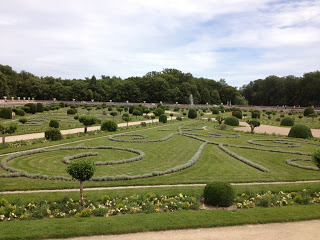 Diane's garden is far more formal than Catherine's, reflecting her strictupbringing and formal mannerisms. The retaining wall in the distanceprotects the garden from the Cher's floods.
Diane's garden is far more formal than Catherine's, reflecting her strictupbringing and formal mannerisms. The retaining wall in the distanceprotects the garden from the Cher's floods.
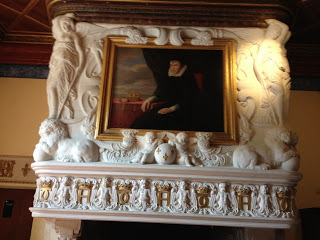 A modern portrait of Catherine, as she looked in her later years,displayed over a spectacular fireplace emblazoned with H for Henri andback-to-back Cs for Catherine. It is said that Coco Chanel was inspired tocreate the logo for her company after seeing Catherine's double-C symbol atChenonceau.
A modern portrait of Catherine, as she looked in her later years,displayed over a spectacular fireplace emblazoned with H for Henri andback-to-back Cs for Catherine. It is said that Coco Chanel was inspired tocreate the logo for her company after seeing Catherine's double-C symbol atChenonceau.
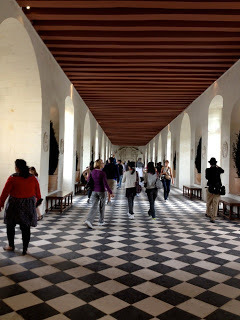 Catherine built this gallery, one of two, atop Diane's bridge, completingher rival's project.
Catherine built this gallery, one of two, atop Diane's bridge, completingher rival's project.
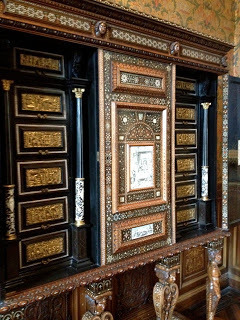 This elaborate cabinet was a wedding gift from Catherine and Henri totheir oldest son, Francis II, and his wife, Mary Queen of Scots.
This elaborate cabinet was a wedding gift from Catherine and Henri totheir oldest son, Francis II, and his wife, Mary Queen of Scots.
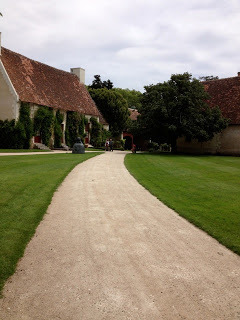 Diane's farm was a money-maker, a testament to her business skills. Itstill grows the flowers displayed in Chenonceau's gardens and thevegetables served in Chenonceau's restaurant.
Diane's farm was a money-maker, a testament to her business skills. Itstill grows the flowers displayed in Chenonceau's gardens and thevegetables served in Chenonceau's restaurant.
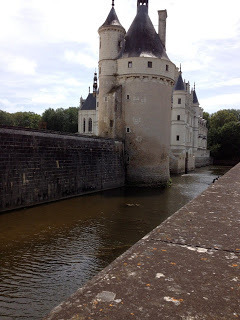 The Cher flows directly under Diane's bridge, topped by Catherine'sgallery. Except for the foundations, the Marques tower in the foreground,restored in the Renaissance style by Thomas Bohier and Katherine Briconnet,is all that remains of the original castle and mill.
The Cher flows directly under Diane's bridge, topped by Catherine'sgallery. Except for the foundations, the Marques tower in the foreground,restored in the Renaissance style by Thomas Bohier and Katherine Briconnet,is all that remains of the original castle and mill.
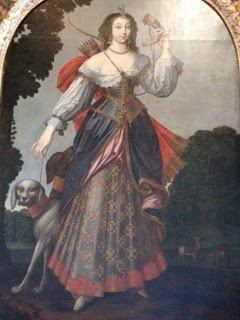 A romanticized portrait of Diane de Poitiers as Diana the Huntress. Anextremely athletic woman, Diane is believed to have taken swims in the Cheron days that she was AT the castle, from a landing on one of the piers ofher bridge.
A romanticized portrait of Diane de Poitiers as Diana the Huntress. Anextremely athletic woman, Diane is believed to have taken swims in the Cheron days that she was AT the castle, from a landing on one of the piers ofher bridge.
McKenna Darby writes romantic historical novels set during the French Renaissance and the American Civil War. Visit her at http://mckennadarby.com
Chenonceau: The ladies’ chateauby McKenna Darby
 Chateau de Chenonceau as seen from Catherine de Medici's garden. It is
Chateau de Chenonceau as seen from Catherine de Medici's garden. It iswidely considered the most beautiful chateau in France and one of the most
beautiful in the worldChenonceau is one of France’s smaller castles. What it lacks in size, however, Chenonceau more than makes up for in history – and in beauty. As Laure Menier, curator of Chenonceau writes in her introduction to one the chateau’s many guidebooks: “The very name of this site evokes music; the vision of it, pure enchantment. Here charm transcends beauty. The majesty and simplicity of Chenonceau touches the heart and the soul.” Poetic, yes, but Chenonceau is every bit of this and more.
The chateau is distinctive in part for being constructed in the middle of the Cher River. The river, placid as a lake on fair days, reflects the castle’s white stone and dainty turrets like a noble lady’s looking glass. Which is appropriate, for Chenonceau is popularly known as “the ladies’ chateau.” Through the centuries, six strong and memorable women built Chenonceau, maintained it, expanded it, loved it, fought over it, and made its place in history.
The first was Katherine Briçonnet. Katherine’s husband, Thomas Bohier, acquired the property from the debt-ridden Marques family in 1496, and proceeded to tear down both the medieval castle and mill that stood there. Only the Marques tower, which Katherine renovated in Renaissance style, still stands near the castle’s front entrance. On the foundations of the previous castle and mill, Katherine and Thomas built a new castle, almost perfectly square. With Thomas was away for long periods, tending to the king’s finances, Katherine supervised most of the construction. The castle’s ornate double doors and an Italian-style coffered-oak ceiling, the oldest surviving example in France, are widely attributed to Katherine’s influence.Shortly after Thomas died, King Francis I seized the chateau as part of a lawsuit against his financiers; Chenonceau became a royal castle. Men were not destined to control the castle, however. Francis died soon after he gained control of the property, and control passed to his son, Henri II.
Henri had two important women in his life: his wife, Catherine de Medici, and his mistress, Diane de Poitiers. Although Catherine assumed she would control the castle, Henri awarded it to Diane instead. The decisions enraged the queen, but Catherine was 20 years younger than her rival. In keeping with her famous motto, “Hate and wait,” Catherine bided her time, expecting that Diane would soon die. Instead, the notoriously athletic and healthy Diane applied her talent for business management to develop a thriving farm at the chateau. She then used the farm’s proceeds and the estate’s rents to renovate and enlarge Chenonceau, constructing some of the most spectacular gardens of the era and adding a scenic bridge that connected the chateau to the far bank of the Cher.
When King Henri died in a tragic jousting accident, Catherine no longer had to wait. She seized Chenonceau, evicted Diane, and set about to put her own mark on the castle. On the opposite side of the chateau from Diane’s garden, Catherine built her own, complete with lemon and orange trees. She also built two galleries on top of Diane’s bridge, a project Diane had planned but never had a chance to execute. The dowager queen also built on Diane’s other accomplishments, transforming her rival’s vineyard into one of France’s finest, importing silkworms, and launching silk production that produced a fabric so fine it was known as “the Queen’s cloth.” She then set about to stage the most elaborate parties in the history of France, including lavish entertainments, sumptuous food, and nation’s first fireworks display, given in honor of her son, the newly crowned King Francis II, and his wife Mary Stuart. For nearly 30 years, for three sons in turn (Catherine survived all but the last), she ruled France as regent from the Thomas Bonier’s Green Study at Chenonceau.
When Catherine’s third son, Henri III, was assassinated on Aug. 1, 1589, Chenonceau passed to his widow, Louise de Lorraine. She transformed Chenonceau into a tomb, painting her bedchamber black and roaming the halls in white, the color of royal mourning. With her death in 1501, Chenonceau lost its last royal resident.The next important woman in Chenonceau’s history was Louise Dupin, who hosted the Enlightenment’s most famous thinkers, from Voltaire to Rousseau, at the chateau. When the French Revolution broke out and rioters threatened to destroy Chenonceau as a symbol of royal excess, Mme. Dupin saved the chateau by reminding the revolutionary mob of the castle’s hospitality to their Enlightenment heroes.
Early in the 20th century, Chenonceau was again touched by war. The chateau, now owned by the Menier family, a dynasty built on chocolate, became a hospital for soldiers wounded in World War I, with a 120-bed ward and a surgical facility set up in Catherine de Medici’s two galleries. The family paid all of the expenses, treating 2,254 soldiers before the war ended. Simone Menier, chief nurse, ran the hospital with her husband, George.
In World War II, Chenonceau played an important role in the French Resistance. On June 22, 1940, France lost a decisive battle that cut the country in two. The line of demarcation between Nazi-controlled France and free France ran along the Cher River. The far side of the bridge was Nazi controlled. The chateau side was free. Although German guards patrolled the river, Simone Meunier unlocked the doors to the gallery whenever the patrols were out of sight, helping hundreds of Jews and French villagers to escape.
 Catherine de Medici's garden reflects her flamboyant style. To the left isDiane's bridge, topped by Catherine's two-story gallery.
Catherine de Medici's garden reflects her flamboyant style. To the left isDiane's bridge, topped by Catherine's two-story gallery. Some of the original Delft tiles at Chenonceau. Except around the edges ofthe room, the tiles are worn down to the red clay underneath.
Some of the original Delft tiles at Chenonceau. Except around the edges ofthe room, the tiles are worn down to the red clay underneath.  Chenonceau, as shown on my admission ticket. Diane de Poitiers built the
Chenonceau, as shown on my admission ticket. Diane de Poitiers built thebridge over the River Cher. Diane's lifelong rival, Catherine de Medici, topped it with a double gallery when she seized the castle from her husband's mistress after the death of Catherine's husband, King Henri II. During WWII, the castle side of the bridge was free France, while the opposite sidewas Nazi occupied. Hundreds escaped Nazi control by slipping across the bridge with assistance from Simone Menier, heir to the Menier chocolatefortune, who worked with the French Resistance.
 A stunning view of the Cher and a corner of Diane's garden from Catherinede Medici's study
A stunning view of the Cher and a corner of Diane's garden from Catherinede Medici's study Ceiling in Catherine de Medici's study, from which she ruled France asregent to her sons for almost THIRTY years. Still in its original state, itfeatures the crest of Thomas Bohier and his wife, Katherine Briconnet, whodemolished the fortified castle and mill that once stood on the site tobuild CHENONCEAU.
Ceiling in Catherine de Medici's study, from which she ruled France asregent to her sons for almost THIRTY years. Still in its original state, itfeatures the crest of Thomas Bohier and his wife, Katherine Briconnet, whodemolished the fortified castle and mill that once stood on the site tobuild CHENONCEAU.  Intertwined H and Cs on the ceiling in Catherine de Medici's bedroom officially stand for Henri andCatherine, but are arranged so they also form an intertwined H and two Ds, forHenri and his mistress Diane de Poitiers.
Intertwined H and Cs on the ceiling in Catherine de Medici's bedroom officially stand for Henri andCatherine, but are arranged so they also form an intertwined H and two Ds, forHenri and his mistress Diane de Poitiers. Diane's garden is far more formal than Catherine's, reflecting her strictupbringing and formal mannerisms. The retaining wall in the distanceprotects the garden from the Cher's floods.
Diane's garden is far more formal than Catherine's, reflecting her strictupbringing and formal mannerisms. The retaining wall in the distanceprotects the garden from the Cher's floods. A modern portrait of Catherine, as she looked in her later years,displayed over a spectacular fireplace emblazoned with H for Henri andback-to-back Cs for Catherine. It is said that Coco Chanel was inspired tocreate the logo for her company after seeing Catherine's double-C symbol atChenonceau.
A modern portrait of Catherine, as she looked in her later years,displayed over a spectacular fireplace emblazoned with H for Henri andback-to-back Cs for Catherine. It is said that Coco Chanel was inspired tocreate the logo for her company after seeing Catherine's double-C symbol atChenonceau. Catherine built this gallery, one of two, atop Diane's bridge, completingher rival's project.
Catherine built this gallery, one of two, atop Diane's bridge, completingher rival's project. This elaborate cabinet was a wedding gift from Catherine and Henri totheir oldest son, Francis II, and his wife, Mary Queen of Scots.
This elaborate cabinet was a wedding gift from Catherine and Henri totheir oldest son, Francis II, and his wife, Mary Queen of Scots.  Diane's farm was a money-maker, a testament to her business skills. Itstill grows the flowers displayed in Chenonceau's gardens and thevegetables served in Chenonceau's restaurant.
Diane's farm was a money-maker, a testament to her business skills. Itstill grows the flowers displayed in Chenonceau's gardens and thevegetables served in Chenonceau's restaurant. The Cher flows directly under Diane's bridge, topped by Catherine'sgallery. Except for the foundations, the Marques tower in the foreground,restored in the Renaissance style by Thomas Bohier and Katherine Briconnet,is all that remains of the original castle and mill.
The Cher flows directly under Diane's bridge, topped by Catherine'sgallery. Except for the foundations, the Marques tower in the foreground,restored in the Renaissance style by Thomas Bohier and Katherine Briconnet,is all that remains of the original castle and mill. A romanticized portrait of Diane de Poitiers as Diana the Huntress. Anextremely athletic woman, Diane is believed to have taken swims in the Cheron days that she was AT the castle, from a landing on one of the piers ofher bridge.
A romanticized portrait of Diane de Poitiers as Diana the Huntress. Anextremely athletic woman, Diane is believed to have taken swims in the Cheron days that she was AT the castle, from a landing on one of the piers ofher bridge.
McKenna Darby writes romantic historical novels set during the French Renaissance and the American Civil War. Visit her at http://mckennadarby.com
Published on February 27, 2013 04:43
February 26, 2013
Video of the Week: Evolution of Mom Dancing
I adore Jimmy Fallon. And while this video may not be historical in context, it is definitely making history! Jimmy Fallon AND the First Lady of the United States, Michelle Obama, doing the Evolution of Mom Dancing. And yes, I sooo do some of those dances! Kudos to the First Lady for breaking it down on national television and for encouraging all families to move together!
Enjoy!!!
Enjoy!!!
Published on February 26, 2013 04:19
February 25, 2013
THE COTTINGLEY FAIRIES by Frances Brody
Today, I'd like to welcome the wonderful historical mystery author, Frances Brody to History Undressed! If you haven't read her book, Dying in the Wool, the first in the Kate Shakelton mystery series, you will want to pick it up, I absolutely loved it! The second book, A Medal for Murder has just released!
THE COTTINGLEY FAIRIESby Frances Brody
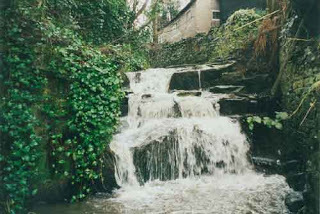 Dying in the Wool, my 1920s Kate Shackleton mystery novel, is set in the fictional mill village of Bridgestead, Yorkshire, based on the real life village of Cottingley. Researching my location, I took a train to Bingley, and walked to Cottingley. There, in 1917, cousins Elsie Wright, age 16, and Frances Griffiths, age 10, photographed fairies.
Dying in the Wool, my 1920s Kate Shackleton mystery novel, is set in the fictional mill village of Bridgestead, Yorkshire, based on the real life village of Cottingley. Researching my location, I took a train to Bingley, and walked to Cottingley. There, in 1917, cousins Elsie Wright, age 16, and Frances Griffiths, age 10, photographed fairies.
I crossed the old stone bridge and walked by the beck (stream) where the girls once played. Frances Griffiths arrived with her mother from South Africa in 1917. After the heat of Africa, Cottingley in spring enchanted Frances. The water murmured its song. She watched butterflies, dragonflies, and saw fairies. Such sightings were not new. Author William Riley knew the Yorkshire dales well. He talked to several people who had spotted pixies in Upper Airedale and Wharfedale.
The girls were scolded for coming home with wet feet, late for tea. In true the-dog-ate-my-homework style, Frances explained that they had stayed so long by the beck because they were watching fairies. They could prove it, too.
Elsie borrowed her father’s Midg quarter-plate camera. Arthur, a keen amateur photographer with his own dark room, dismissed the fairy photographs as a prank.
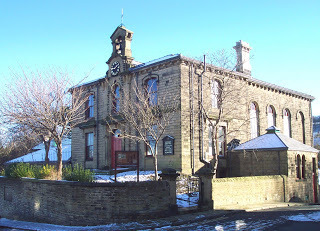 There are five photographs: Frances with leaping fairy; Frances with five fairies; Elsie with gnome; fairy offering a harebell to Elsie; fairy sunbath.
There are five photographs: Frances with leaping fairy; Frances with five fairies; Elsie with gnome; fairy offering a harebell to Elsie; fairy sunbath.
In 1919, Elsie’s mother Polly, believing the photographs to be genuine, attended the Bradford Theosophical Society lecture, “Fairy Life”. She showed the photographs to the speaker. The Theosophical Society then displayed the photographs at their Annual Conference in Harrogate. Human evolution towards perfectibility was a central tenet of the Society. According to the editor of Spiritualist Magazine, the photographs showed an example of life forms which had ‘developed along some separate line of evolution.’ Among a war-weary and bereaved public, many wanted to believe that here was a corner of fairyland.
Arthur Conan Doyle supplied a camera, to ensure there was no possibility of tampering with a fresh photograph. He studied the photographs carefully, had them analysed, and pronounced them authentic.
It was too late for Elsie and Frances to admit that Elsie had traced images of fairies from a book and created cut-outs. Their ‘bit of fun’ had fooled too many clever people. They were embarrassed. In the 1980s, the cousins came clean. Elsie said, ‘Two village kids and a brilliant man like Conan Doyle – well, we could only keep quiet.’
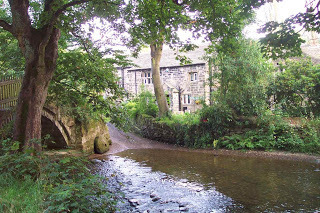 From the first, there were sceptics. Poet and essayist Maurice Hewlett wrote in John o’London’s Weekly, ‘It is easier to believe in faked photographs than in fairies.’
From the first, there were sceptics. Poet and essayist Maurice Hewlett wrote in John o’London’s Weekly, ‘It is easier to believe in faked photographs than in fairies.’
Frances continued to maintain that the last photograph was genuine. Frances’s daughter shares this view, as does Joe Cooper, author of “The Case of the Cottingley Fairies.”
Did I catch a glimpse of gossamer wing on my visit to Cottingley? Sadly, no. But there is a certain way of looking, from the corner of the eye, while lying very still in long grass, and feeling the earth’s energy. Maybe next time.
Meanwhile, meet the fairies: http://www.cottingleyconnect.org.uk/
For more about Frances Brody and the Kate Shackleton books, visit www.frances-brody.com
Photographs of Cottingley Town Hall, Beckfoot Bridge and the waterfall courtesy of Margaret Krupa
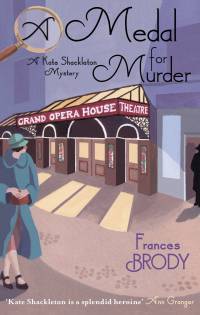 A pawn-shop robbery -
A pawn-shop robbery -
It's no rest for the wicked as Kate Shackleton picks up her second professional sleuthing case. But exposing the culprit of a pawn-shop robbery turns sinister when her investigation takes her to Harrogate - and murder is only one step behind ...
A fatal stabbing -
A night at the theatre should have been just what the doctor ordered, until Kate stumbles across a body in the doorway. The knife sticking out of its chest definitely suggests a killer in the theatre's midst.
A ransom demand -
Kate likes nothing better than a mystery - and nothing better than solving them. So when a ransom note demands £1,000 for the safe return of the play's leading lady, the refined streets of Harrogate play host to Kate's skills in piecing together clues - and luring criminals out of their lairs ...
THE COTTINGLEY FAIRIESby Frances Brody
 Dying in the Wool, my 1920s Kate Shackleton mystery novel, is set in the fictional mill village of Bridgestead, Yorkshire, based on the real life village of Cottingley. Researching my location, I took a train to Bingley, and walked to Cottingley. There, in 1917, cousins Elsie Wright, age 16, and Frances Griffiths, age 10, photographed fairies.
Dying in the Wool, my 1920s Kate Shackleton mystery novel, is set in the fictional mill village of Bridgestead, Yorkshire, based on the real life village of Cottingley. Researching my location, I took a train to Bingley, and walked to Cottingley. There, in 1917, cousins Elsie Wright, age 16, and Frances Griffiths, age 10, photographed fairies.I crossed the old stone bridge and walked by the beck (stream) where the girls once played. Frances Griffiths arrived with her mother from South Africa in 1917. After the heat of Africa, Cottingley in spring enchanted Frances. The water murmured its song. She watched butterflies, dragonflies, and saw fairies. Such sightings were not new. Author William Riley knew the Yorkshire dales well. He talked to several people who had spotted pixies in Upper Airedale and Wharfedale.
The girls were scolded for coming home with wet feet, late for tea. In true the-dog-ate-my-homework style, Frances explained that they had stayed so long by the beck because they were watching fairies. They could prove it, too.
Elsie borrowed her father’s Midg quarter-plate camera. Arthur, a keen amateur photographer with his own dark room, dismissed the fairy photographs as a prank.
 There are five photographs: Frances with leaping fairy; Frances with five fairies; Elsie with gnome; fairy offering a harebell to Elsie; fairy sunbath.
There are five photographs: Frances with leaping fairy; Frances with five fairies; Elsie with gnome; fairy offering a harebell to Elsie; fairy sunbath. In 1919, Elsie’s mother Polly, believing the photographs to be genuine, attended the Bradford Theosophical Society lecture, “Fairy Life”. She showed the photographs to the speaker. The Theosophical Society then displayed the photographs at their Annual Conference in Harrogate. Human evolution towards perfectibility was a central tenet of the Society. According to the editor of Spiritualist Magazine, the photographs showed an example of life forms which had ‘developed along some separate line of evolution.’ Among a war-weary and bereaved public, many wanted to believe that here was a corner of fairyland.
Arthur Conan Doyle supplied a camera, to ensure there was no possibility of tampering with a fresh photograph. He studied the photographs carefully, had them analysed, and pronounced them authentic.
It was too late for Elsie and Frances to admit that Elsie had traced images of fairies from a book and created cut-outs. Their ‘bit of fun’ had fooled too many clever people. They were embarrassed. In the 1980s, the cousins came clean. Elsie said, ‘Two village kids and a brilliant man like Conan Doyle – well, we could only keep quiet.’
 From the first, there were sceptics. Poet and essayist Maurice Hewlett wrote in John o’London’s Weekly, ‘It is easier to believe in faked photographs than in fairies.’
From the first, there were sceptics. Poet and essayist Maurice Hewlett wrote in John o’London’s Weekly, ‘It is easier to believe in faked photographs than in fairies.’ Frances continued to maintain that the last photograph was genuine. Frances’s daughter shares this view, as does Joe Cooper, author of “The Case of the Cottingley Fairies.”
Did I catch a glimpse of gossamer wing on my visit to Cottingley? Sadly, no. But there is a certain way of looking, from the corner of the eye, while lying very still in long grass, and feeling the earth’s energy. Maybe next time.
Meanwhile, meet the fairies: http://www.cottingleyconnect.org.uk/
For more about Frances Brody and the Kate Shackleton books, visit www.frances-brody.com
Photographs of Cottingley Town Hall, Beckfoot Bridge and the waterfall courtesy of Margaret Krupa
 A pawn-shop robbery -
A pawn-shop robbery -
It's no rest for the wicked as Kate Shackleton picks up her second professional sleuthing case. But exposing the culprit of a pawn-shop robbery turns sinister when her investigation takes her to Harrogate - and murder is only one step behind ...
A fatal stabbing -
A night at the theatre should have been just what the doctor ordered, until Kate stumbles across a body in the doorway. The knife sticking out of its chest definitely suggests a killer in the theatre's midst.
A ransom demand -
Kate likes nothing better than a mystery - and nothing better than solving them. So when a ransom note demands £1,000 for the safe return of the play's leading lady, the refined streets of Harrogate play host to Kate's skills in piecing together clues - and luring criminals out of their lairs ...
Published on February 25, 2013 05:10
February 22, 2013
Historical Romance Review: A Most Scandalous Proposal

A Most Scandalous Proposalby Ashlyn Macnamara
Review by Kathleen Bittner-Roth
About the Book
After watching her beloved sister Sophia pine over the ton’s Golden Boy for years, Miss Julia St. Claire has foresworn love and put herself firmly on the shelf. Unfortunately, her social-climbing mother and debt-ridden father have other ideas, and jump at the chance to marry Julia off to the newly-named Earl of Clivesden…the man of Sophia’s dreams.
Since resigning his Cavalry commission, Benedict Revelstoke has spent his time in London avoiding the marriage mart. But when he discovers that the Earl of Clivesden has set Julia in his sights, Benedict tries to protect his childhood best friend from the man’s advances—only to discover more than friendship driving his desire to defend her. He surprises them both with the force of his feelings, but when she refuses him and her father announces her betrothal, he fears he’s lost her forever—until Julia approaches him with a shocking scheme that will ruin her for all respectable society…
…and lead them into an exquisite world of forbidden pleasures.
Review
Debut Author Ashlyn Macnamara has hit a home run her first time at bat with her Regency novel A MOST SCANDALOUS PROPOSAL. When two sisters, Julia and Sophia St. Claire, invite you into their colorful world, the detail the author injects into the characters is so captivating, you’ll have trouble putting the book down. Macnamara takes you into the heart of even the least significant of secondary characters with such graceful ease, before you realize it, you’re lost not only in a well-crafted story, but you’ll want to highlight both the clever repartee between hero and heroine, and the lovely prose so you can revisit the sisters long after you’ve turned the last page. Some have compared this story to Jane Austin’s Sense and Sensibility, but I’d wager when the reader gets to some of the hot love scenes, Austin is history.
The story jumps off the page in the first two paragraphs with the Earl of Clivesden placing a wager for Julia’s hand. He’s a gorgeous but deceitful person, one her sister, Sophia, thinks is the only man for her. By the end of the chapter, you’ll be so engrossed in the story, you’ll be hoping Clivesden meets with a rather unfortunate accident so the two sisters can get on with meeting the loves of their lives.
Here’s an author who’ll be on my “must read” list for a very long time. I suspect she’ll be on yours as well. A MOST SCANDALOUS PROPOSAL is available February 26th. Her sequel A MOST DEVLISH ROGUE IS due in August. Check out her website for a couple of hot book covers and an even hotter book trailer: http://ashlynmacnamara.net/
Well done, Ashlyn Macnamara.
Published on February 22, 2013 04:57
Weekend Recommended Read! -- It Stings so Sweet by Stephanie Draven
Happy Friday history lovers! My weekend recommended read (a new feature), is a bit on the naughty side! It's a 1920's erotic novel, by Stephanie Draven, that I thoroughly devoured. The 1920's is a fascinating time period that I feel we don't see enough of in novels. Kudos to Ms. Draven for bringing the times to life!
*Warning, this book may scandalize you!*
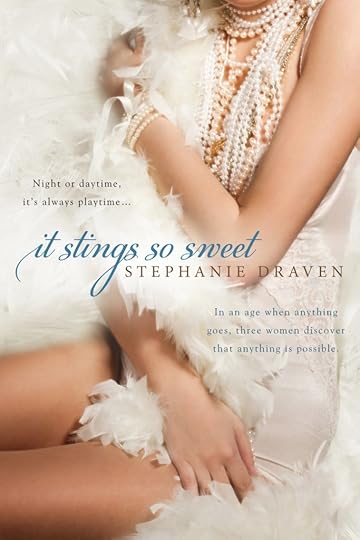
They vibrated with incendiary Jazz. They teemed with sexual abandon. The Twenties were roaring and the women–young, open, rebellious, and willing–set the pace and pushed the limits with every man they met…
In the aftermath of a wild, liquor-soaked party, three women from very different social classes are about to live out their forbidden desires.
Society girl, Nora Richardson’s passionate nature has always been a challenge to her ever-patient husband. Now he wants out of the marriage and she has just this one night to win him back. The catch? He wants to punish her for her bad behavior. Nora is offended by her husband’s increasingly depraved demands, but as the night unfolds, she discovers her own true nature and that the line between pain and pleasure is very thin indeed.
Meanwhile, Clara Cartwright, sultry siren of the silent screen, is introduced to a mysterious WWI Flying Ace. If Clara, darling of the scandal sheets, knows anything, it’s men. And she’s known plenty. But none of them push her boundaries like the aviator, who lures her into a ménage with a stranger in a darkened cinema then steals her jaded heart.
Working class girl Sophie O’Brien has more important things on her mind than pleasures of the flesh. But when her playboy boss, the wealthy heir to the Aster family fortune, confronts her with her diary of secret sex fantasies, she could die of shame. To her surprise, he doesn’t fire her; instead, he dares her to re-enact her boldest fantasies and Sophie is utterly seduced.
One party serves as a catalyst of sexual awakening. And in an age when anything goes, three women discover that anything is possible…
“Nuanced, complex characters who are both strikingly modern and very much of their time…The balance of sin and sweetness is as perfect as a Prohibition cocktail.” – RTBookReviews, Top Pick!
Read it!Available in print and ebook (print copies are available in your local B&N stores)
AmazonBarnes and Noble
*Warning, this book may scandalize you!*

They vibrated with incendiary Jazz. They teemed with sexual abandon. The Twenties were roaring and the women–young, open, rebellious, and willing–set the pace and pushed the limits with every man they met…
In the aftermath of a wild, liquor-soaked party, three women from very different social classes are about to live out their forbidden desires.
Society girl, Nora Richardson’s passionate nature has always been a challenge to her ever-patient husband. Now he wants out of the marriage and she has just this one night to win him back. The catch? He wants to punish her for her bad behavior. Nora is offended by her husband’s increasingly depraved demands, but as the night unfolds, she discovers her own true nature and that the line between pain and pleasure is very thin indeed.
Meanwhile, Clara Cartwright, sultry siren of the silent screen, is introduced to a mysterious WWI Flying Ace. If Clara, darling of the scandal sheets, knows anything, it’s men. And she’s known plenty. But none of them push her boundaries like the aviator, who lures her into a ménage with a stranger in a darkened cinema then steals her jaded heart.
Working class girl Sophie O’Brien has more important things on her mind than pleasures of the flesh. But when her playboy boss, the wealthy heir to the Aster family fortune, confronts her with her diary of secret sex fantasies, she could die of shame. To her surprise, he doesn’t fire her; instead, he dares her to re-enact her boldest fantasies and Sophie is utterly seduced.
One party serves as a catalyst of sexual awakening. And in an age when anything goes, three women discover that anything is possible…
“Nuanced, complex characters who are both strikingly modern and very much of their time…The balance of sin and sweetness is as perfect as a Prohibition cocktail.” – RTBookReviews, Top Pick!
Read it!Available in print and ebook (print copies are available in your local B&N stores)
AmazonBarnes and Noble
Published on February 22, 2013 04:52
February 21, 2013
Video of the Week: Downton Abbey Performs One Direction
*Holds hands up and looks shame-faced at the floor*
My husband and I -- according to my grandmother -- are the last people on earth to begin watching Downton Abbey. Yes, we've just begun the very first season, and yes we totally love the show. And Downton Abbey is the inspiration behind this week's video. I love One Direction's song, What Makes You Beautiful, so when someone put this video together... I LOVED IT!
Enjoy!
My husband and I -- according to my grandmother -- are the last people on earth to begin watching Downton Abbey. Yes, we've just begun the very first season, and yes we totally love the show. And Downton Abbey is the inspiration behind this week's video. I love One Direction's song, What Makes You Beautiful, so when someone put this video together... I LOVED IT!
Enjoy!
Published on February 21, 2013 03:57
February 20, 2013
Castle of the Week: Cardiff Castle
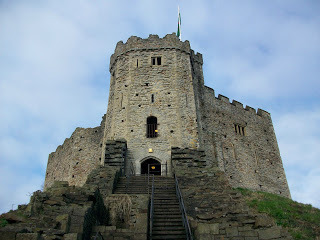 Welcome back to another castle of the week! I admit this is one of my favorite days because I get to visit or revisit so many interesting castles! Today we travel to...
Welcome back to another castle of the week! I admit this is one of my favorite days because I get to visit or revisit so many interesting castles! Today we travel to...Cardiff Castleby Evonne Wareham
The castle has a strategic position on the South Wales coast, beside the River Taff, but the development of Cardiff around it has now put it well within the city, at the end of the two main shopping streets. There are Roman remains on the site and a twelve sided, stone built Shell Keep, with a water filled moat, that began its evolution as a Norman construction, probably made of wood, but Cardiff Castle is best known as an outstanding example of Victorian Gothic. The meeting in 1865 of the Third Marquess of Bute, then the wealthiest man in the world, with architect/designer William Burges, formed a partnership that lasted for years. Lord Bute was rich. Burges was dedicated, some might say obsessive, over detail and consequently very expensive. They were both captivated by the Middle Ages. Serendipity at its finest.
The Butes were a Scottish family who used the Castle as a summer home. Under Burges’s direction it was transformed into a Medieval fairy tale – towers, and turrets, stained glass, stonework, carpentry and painting on themes from legends, chivalry, history, the zodiac, the elements, animals, fruit and flowers, insects and birds, hieroglyphics, runes …
Many rooms have themes – the Arab Room, with a golden ceiling, the Winter Smoking Room equipped with all the ‘boys’ toys’ of the day, the Nursery, with tiled murals of children’s stories. The result is amazing, or abominable, depending on your taste! As you can guess, I am a fan. The photographs barely give a flavor of the effect. The interior shots, taken without flash, for conservation reasons, can only give an impression of the colors and craftsmanship. The full impact, ‘in the flesh’ is quite stunning and a little overwhelming. The closest thing I can use for comparison are the paintings of the Pre-Raphaelites, who were interested in similar themes and use of color. Outside a new Clock Tower was created, decorated with figures depicting the planets. And then there is the Animal Wall, with stone statues that gaze or glare down at pedestrians going about their business in the street below. It’s a fantastic creation.
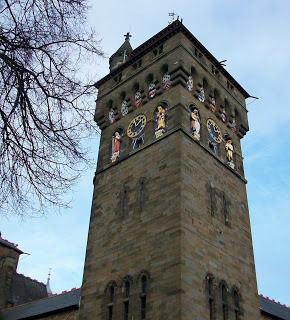 The clock tower
The clock tower
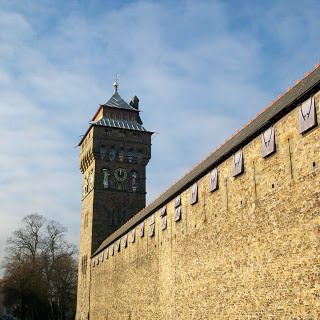 Outer wall and Tower
Outer wall and Tower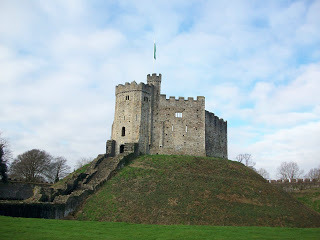 The Keep
The Keep
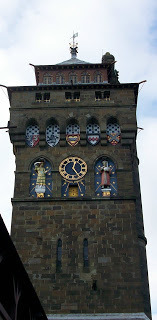 The Tower - Burges figures of the Planets
The Tower - Burges figures of the Planets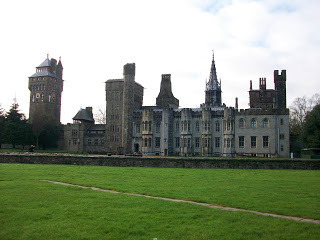 Main building
Main building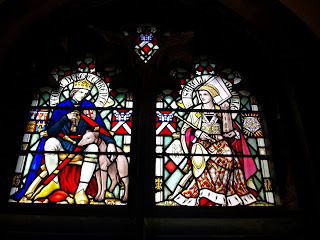 Stained glass
Stained glass Detail from the banqueting hall
Detail from the banqueting hall
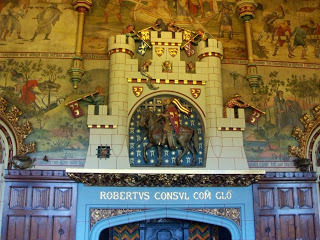 Fireplace in the banqueting hall
Fireplace in the banqueting hall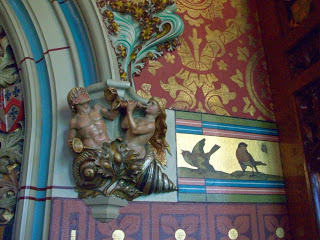 Detail of the lavish decorations
Detail of the lavish decorations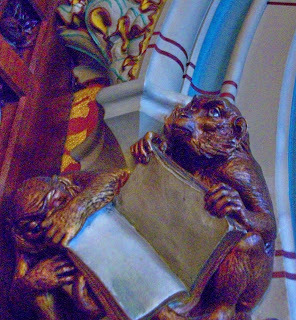 Monkeys - a favorite motiff
Monkeys - a favorite motiff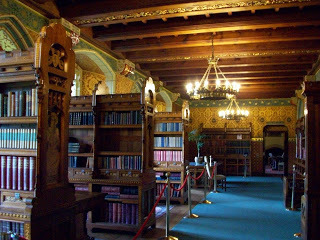 The Library
The Library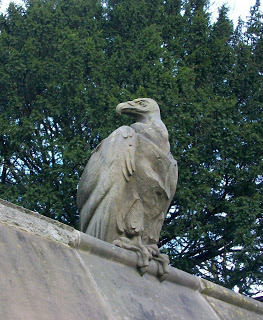 Vulture
Vulture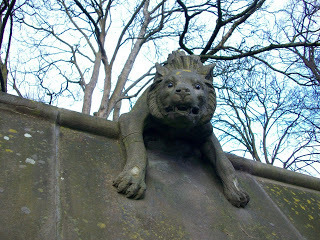 Hyena
Hyena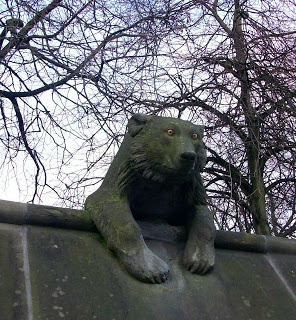 Bear
Bear
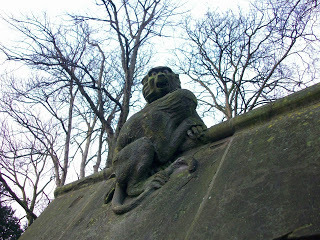 Apes
Apeshttp://www.cardiffcastle.com/
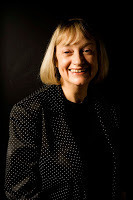 Biography
Biography
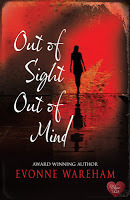 Evonne is a Welsh author of contemporary romantic suspense who lives just outside Cardiff. Her award winning first novel Never Coming Home will be available in paperback in the US in March, to be followed by Out of Sight Out of Mind, a paranormal romantic thriller, in May. Evonne will be attending the RT Booklovers Convention in Kansas City in May 2013.
Evonne is a Welsh author of contemporary romantic suspense who lives just outside Cardiff. Her award winning first novel Never Coming Home will be available in paperback in the US in March, to be followed by Out of Sight Out of Mind, a paranormal romantic thriller, in May. Evonne will be attending the RT Booklovers Convention in Kansas City in May 2013.
www.evonnewareham.comhttp://evonneonwednesday.blogspot.co.uk
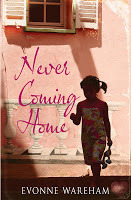
NOTES ON THE PHOTOS
The Castle buildings are within extensive grounds, surrounded by a high stone wall. Once through the entrance gate the Keep is straight ahead. The main building – the family residence – is off to the left. Within the building, the Banqueting Hall is the largest room. The Animal Wall is outside the Castle walls and the Clock Tower is visible from the street.
Published on February 20, 2013 05:15
February 18, 2013
Holly Bush Virtual Book Tour -- Giveaway!
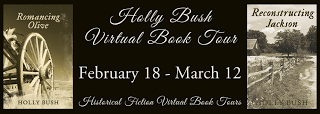 Romancing Olive
Romancing Olive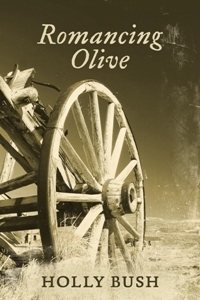 Publication Date: November 1, 2011 | BookBaby | 205p
Publication Date: November 1, 2011 | BookBaby | 205pIn 1891, spinster librarian, Olive Wilkins, is shocked to learn of her brother’s violent death at a saloon gaming table and her sister-in-law’s subsequent murder, traveling far from her staid life to rescue her niece and nephew, now orphans. She arrives to find the circumstances of her brother’s life deplorable and her long held beliefs of family and tradition, shaken.
Accustomed to the sophistication of Philadelphia, Olive arrives in Spencer, Ohio, a rough and tumble world she is not familiar with, facing two traumatized children. Her niece and nephew, Mary and John, have been living with a neighboring farmer, widower Jacob Butler, the father of three young children of his own and a man still in pain from the recent loss of his wife.
Real danger threatens Olive and Mary and John while Jacob and his own brood battle the day-to-day struggles for survival. Will Olive and Jacob find the strength to fight their battles alone or together? Will love conquer the bitterness of loss and broken dreams?
Reconstructing Jackson
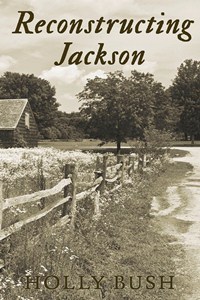 Publication Date: September 25, 2012 | BookBaby | 191p
Publication Date: September 25, 2012 | BookBaby | 191p1867 . . . Southern lawyer and Civil War veteran, Reed Jackson, returns to his family’s plantation in a wheelchair. His father deems him unfit, and deeds the Jackson holdings, including his intended bride, to a younger brother. Angry and bitter, Reed moves west to Fenton, Missouri, home to a cousin with a successful business, intending to start over.
Belle Richards, a dirt poor farm girl aching to learn how to read, cleans, cooks and holds together her family’s meager property. A violent brother and a drunken father plot to marry her off, and gain a new horse in the bargain. But Belle’s got other plans, and risks her life to reach them.
Reed is captivated by Belle from their first meeting, but wheelchair bound, is unable to protect her from violence. Bleak times will challenge Reed and Belle's courage and dreams as they forge a new beginning from the ashes of war and ignorance.
About the Author
 Holly Bush was born in western Pennsylvania to two avid readers. There was not a room in her home that did not hold a full bookcase. She worked in the hospitality industry, owning a restaurant for twenty years and recently worked as the sales and marketing director in the hospitality/tourism industry and is credited with building traffic to capacity for a local farm tour, bringing guests from twenty-two states, booked two years out. Holly has been a marketing consultant to start-up businesses and has done public speaking on the subject.
Holly Bush was born in western Pennsylvania to two avid readers. There was not a room in her home that did not hold a full bookcase. She worked in the hospitality industry, owning a restaurant for twenty years and recently worked as the sales and marketing director in the hospitality/tourism industry and is credited with building traffic to capacity for a local farm tour, bringing guests from twenty-two states, booked two years out. Holly has been a marketing consultant to start-up businesses and has done public speaking on the subject.Holly has been writing all of her life and is a voracious reader of a wide variety of fiction and non-fiction, particularly political and historical works. She has written four romance novels, all set in the U.S. West in the mid 1800’s. She frequently attends writing conferences, and has always been a member of a writer’s group.
Holly is a gardener, a news junkie, has been an active member of her local library board and loves to spend time near the ocean. She is the proud mother of two daughters and the wife of a man more than a few years her junior.
www.hollybushbooks.com
Leave a comment w/your email address for your chance to win one eBook of either title (winner's choice). The eBook files available are PDF, mobi & ePub. Open to international readers!
Published on February 18, 2013 08:14



